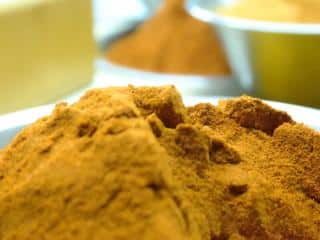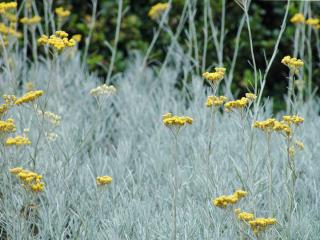

The curry plant, botanically known as “Helichrysum italicum“, is a superstar in the world of essential oils. Who knew that distilling its blossoms could have such impressive results? Use these essential oils in a massage and voilà! Those stubborn bruises will ebb away.
On a different note, you probably know that the curry plant makes a tasty and delicate substitute for the curcuma-based spice of the same name? Chicken, rice, fish – you name it, this plant adds the perfect hint of aroma. Just pluck a few young leaves right before use and add them at the end of cooking to capture their fresh, potent aromas.
The curry plant does more than just spice up your dishes. Its dried branches can make your house smell fresh and airy, and its medicinal properties, both external and internal, are worth getting to know.
What are the therapeutic virtues of the curry plant? How does it benefit health? How can you get the most out of it?
Phytotherapists love this plant for its active ingredients, particularly the flowers brimming with monoterpenes and quiterpenes.

Whether used internally or externally, the curry plant does wonders. It speeds up wound healing, soothes frostbite and chapped skin, and improves blood circulation.
As a tea, the curry plant battles against heartburn and other reflux issues (dyspepsia). As a decongestant, it calms the cough and eases the airways. It’s also a very effective painkiller and anti-inflammatory.
Thanks to the italidione it contains, its essential oil soothes bruises and burns.
In lotion form, the curry plant aids circulation problems and eases arthritis, rheumatism, skin conditions (eczema, acne).
In addition, it’s a bactericide and has antispasmodic virtues.
Curry is consumed and used in a variety of forms and preparations: herbal tea, infusion, cream, essential oil, lotion, inhalation, and even fumigation.
For internal use, toss a handful of flowers into a pot of hot water to prepare a infusion. Let it steep, then chill in the fridge for a few hours before savoring it.
When it comes to external use, the effects of the essential oil are a particularly effective when mixed with an argan type vegetable oil.

In times of stress, take a load off your shoulders by adding 10 drops of the essential oil to the bathwater.
To control acne, it’s recommended to apply a curry lotion several times a week on the area to treat.
For inhalation, dilute 3 to 5 drops of essential oil in a bowl of hot water, then bask in the goodness!
Hailing from Southern Europe (the Mediterranean), curry, commonly known as curry plant or curry herb, is a beautiful garden choice with its yellow umbels. This perennial aromatic plant belongs to the Asteraceae family and its aroma is a favorite in the kitchen. Its silvery gray, threadlike leaves are similar to those of lavender, and they also grow in thick tufts. Stems are coated with a thick fuzz, and its gold-colored flowers last a very long time, hence the name “Immortal” or “Italian Immortal.”
In Greek mythology, the flowers of the “Immortal,” woven into a halo, were used as a headdress for the god Apollo. This vain deity wanted to remind everyone of his immortality. At the time, the Greek peoples didn’t recognize any therapeutic virtues in it.
However, it later earned recognition as a beauty plant thanks to Princess Nausica (daughter of Alkinoos, king of the Phoenicians). It’s chronicled that she used it for body and face care.
According to some writings, curry was used in the 20th century to make funeral wreaths. During World War I, some hospitals used it to purify soldiers’ bodies.
Over time, therapists recognized its therapeutic benefits, particularly in treating respiratory and skin conditions, and even in regulating blood circulation.